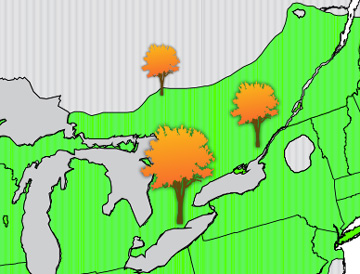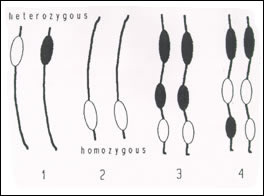The Importance of Genetic Diversity
Genetic diversity is the foundation of biodiversity, although too often ignored. For three important reasons, we need to better understand it as we manage our native forests:
For ecosystem services
Our forest ecosystems provide many services we need in most of southcentral Ontario’s diverse climates and sites. Healthy, diverse forests moderate local climate, conserve soil and ground water, enrich soil, and provide economic benefits from logging. There is increasing evidence of their direct links to human health – see Forests Ontario’s Healthy Dose of Green publication.
Species diversity gives us trees that are adapted to hot summers versus cold winters; to moist versus dry soils; to heavy shade versus exposed conditions.
In the ice storm of 1998, eastern Ontario’s rich species diversity allowed the forests to continue to exist and thrive, although many trees and even whole species suffered. Compare this to the effect of Emerald Ash Borer in southwest Ontario where there were few forests, with ash as a dominant species, and the result is a fragile forest landscape and reduced services.
For evolutionary capacity
Genetic diversity within a species means that, barring catastrophic events, some individuals will be adapted to withstand pressures and survive, and therefore the species will survive. For species threatened with exotic diseases and pests, such as chestnut, butternut and now beech and ash, we hope that genetic tolerance can be found to ensure these species’ continued presence in our forests. The Elm Recovery Program at The Arboretum, University of Guelph is working with such tolerance in elm. If we had reduced these species to a few clones on our landscape that were desired for specific products or aesthetics, it is unlikely we would be successful in finding natural tolerance.
For economic potential
When we conserve the full breadth of native genetic diversity, we have a greater opportunity to select certain trees to breed for traits which will bring economic benefit. It may be sweeter sap for maple syrup production, faster growth in white pine, better nut production in walnut, or stem form and branch angle for windbreak or Christmas trees.
Genetic Diversity: A Primer
Most people recognize the first level of species diversity. Southcentral Ontario has a rich diversity of species, over 100 woody species—each with a particular function in our landscape, which is itself very diverse in climate, landforms and soils.

Within a single species there are additional levels of genetic diversity. Many of our species occur across a large geographic range, thus population diversity or adaptive variation has evolved. This means, for example, that red oak in eastern Ontario evolved to be particularly adapted to those conditions. While in southwestern Ontario, in a different set of conditions the red oak evolved differently. The degree to which this diversity exists varies by species, but generally speaking it is not well known for most of our native species. This population diversity is why seed source matters in reforestation programs. You want to ensure that the source of seed is adapted to the conditions of your planting site. The Ontario Ministry of Natural Resources has developed Tree Seed Zones for Ontario to help people understand what sources of seed and seedlings are adapted to their areas.
For more information about population diversity and Tree Seed Zones, visit:
A second level is individual diversity—within a population of a single species. Trees within one stand can differ in many ways including growth rate or seed production or disease tolerance. Some differences are due to the environment (light/spacing/soil depth), however research has shown that some differences are due to genetic differences. It’s how one tree is slightly different than its neighbour, but still the same species. This is very important and accounts for most of the genetic variation within a species.
Some selections that have been made from this individual diversity include
- Fast Growth — White pine
- Disease Resistance – Elm
- Higher sap sweetness – sugar maple
- Columnar street tree form – ash
But if we don’t conserve the full suite of diversity, if we reduce a species to the few selections that have current economic importance, then we risk losing the species to future pressures such as invasive alien insects and diseases.
The third level of diversity is within an individual tree’s genetic code. Maladapted genes can result from the normal process of random mutation, but they are often hidden in a recessive state. This is especially true for many of our tree species that are outcrossing – ones that breed largely through pollination from distant, unrelated trees, brought by wind or insects. But sometimes outcrossing is prevented or reduced. For example, white spruce stands in southern Ontario have become smaller and smaller and also more distant from each other. The likelihood that related individuals will breed increases and recessive genes can become expressed, often with negative results – no seed set, lack of chlorophyll or poor vigour of the seedlings.
Trees, as with humans, have chromosomes with genes at specific locations that control specific characteristics or physiological functions – an example in humans is eye colour. Alleles are the different forms of a gene at a specific location – again an example in humans is the gene for blue eye colour versus brown. Within a population there can be several alleles (the different forms of a gene). Measurements for different tree species have shown ranges of 1 to 10 – this is referred to as allele richness.

One gene is inherited from the mother and one from the father. Heterozygosity is when the two alleles at a gene location are different and homozygosity means that the two genes are of the same allelic form (figure below). Genes that are recessive are only exposed when present in the homozygous state e.g. blue eyes. The relevance of this arrangement becomes apparent when an organism has a form of a gene that is detrimental, for example, an allele for no chlorophyll. If the plant is homozygous for this allele it will not survive. The number of gene locations that are homozygous (two genes the same) increase when related trees mate and if an allele is detrimental, it manifests itself as inbreeding depression.
Most tree species are outcrossing with high rates of pollen exchange, so they have high levels of heterozygosity. However this also means that trees have been able to carry a “high genetic load” of detrimental genes. They don’t often occur in the homozygous state and therefore are not exposed to selection pressure, and hence purged from the population. A tree species that occurs naturally as scattered individuals or small groups may be adapted to inbreeding because a majority of detrimental recessive genes have been purged and therefore there is no evidence of inbreeding depression when related trees mate.
In a species with a high genetic load, when two trees that are related mate, the resulting seedling can show signs of inbreeding depression. They exhibit less vigour or may not be able to survive at all. In the most extreme situation when self- pollination occurs (such as an isolated tree) little viable seed is produced. Under natural conditions, in most species of trees, female flowers are pollinated by many unrelated trees and relatively less related trees. Millions of seedlings are produced and seedlings of low vigour (in-bred seedlings) are eliminated over time. When we have only small isolated woodlots the chance that related trees will mate is greater and increases over each generation. This is another reason it is important to have larger woodlots and a less fragmented forest landscape. In addition, when we do manage isolated woodlots we must take care to maintain large numbers (at least 100 if possible) of mature individuals of one species to provide regeneration if we want to ensure a genetically healthy stand for the next generation.
Excerpt from: Genetic Diversity – Invisible but Vital to Woodland Conservation and Restoration, Nielsen, Cathy, OMNR, Kemptville, June 2000